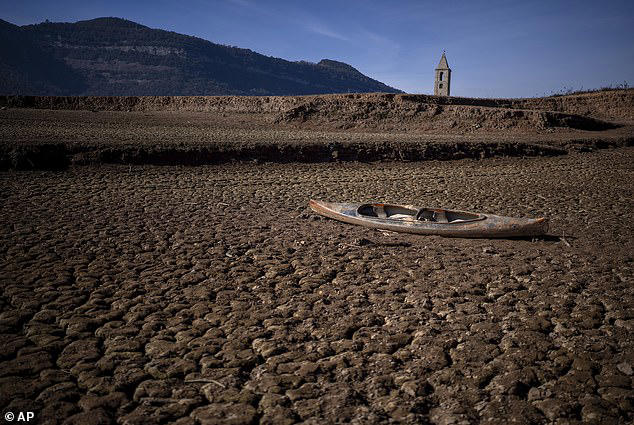Climate Whiplash: A Growing Threat To Cities Worldwide

Table of Contents
Understanding Climate Whiplash and its Urban Impacts
Climate whiplash refers to the rapid succession of contrasting extreme weather events within a short period. This isn't simply about experiencing both heat and cold in a year; it's about the shocking unpredictability and intensity of these shifts. For instance, a prolonged drought might be abruptly followed by devastating flash floods, or an intense heatwave quickly gives way to an unexpected and damaging freeze. Climate change, with its amplified warming effect, is the primary driver behind this escalating phenomenon. The increased energy in the atmosphere fuels more volatile weather systems, leading to more frequent and intense occurrences of climate whiplash.
- Increased frequency of extreme precipitation events: Heavier rainfall in shorter periods overwhelms drainage systems, leading to widespread flooding.
- More intense heatwaves and cold snaps: These dramatic temperature swings place immense stress on infrastructure and human health.
- Higher risk of wildfires followed by flash floods: Dry conditions fuel wildfires, leaving the landscape vulnerable to erosion and flash floods when rain eventually arrives.
- Disruption of traditional seasonal patterns: The predictability of weather seasons, crucial for agriculture and urban planning, is eroding, leading to increased uncertainty and vulnerability.
Urban areas are particularly vulnerable to climate whiplash due to their high population density, often aging infrastructure, and frequently limited green spaces. These factors amplify the impacts of extreme weather events, creating cascading effects that can cripple a city's ability to function.
The Economic Burden of Climate Whiplash on Cities
The financial toll of climate whiplash on cities is staggering. The damage inflicted on infrastructure – roads, bridges, power grids, and transportation networks – requires immense investment for repair and reconstruction. Disruptions to essential services, such as water and sanitation, further escalate costs. Businesses suffer significant losses due to closures, supply chain disruptions, and decreased tourism.
- Costs of emergency response and disaster relief: Each extreme event necessitates costly emergency responses, often stretching already strained budgets.
- Repair and reconstruction of damaged infrastructure: Rebuilding damaged infrastructure is a lengthy and expensive process, often requiring substantial government funding.
- Loss of revenue from tourism and business closures: Extreme weather events can deter tourists and force businesses to close temporarily or permanently.
- Increased insurance premiums and potential for bankruptcies: The increased risk of damage leads to higher insurance premiums, potentially pushing businesses and municipalities towards bankruptcy.
Vulnerable populations and low-income communities often bear the brunt of these economic impacts, lacking the resources to cope with the aftermath of extreme weather events.
Public Health and Climate Whiplash: A Growing Concern
Climate whiplash poses a significant and growing threat to public health. The rapid shifts in temperature and precipitation patterns create a breeding ground for disease and exacerbate existing health problems.
- Increased incidence of heat-related illnesses and deaths: Extreme heatwaves can lead to heatstroke, dehydration, and cardiovascular complications.
- Spread of vector-borne diseases (e.g., Zika, malaria): Changing weather patterns alter the habitats of disease-carrying insects, increasing the risk of vector-borne illnesses.
- Respiratory problems from air pollution: Wildfires, exacerbated by drought conditions, release harmful pollutants into the air, leading to respiratory problems.
- Mental health consequences of trauma and displacement: Repeated exposure to extreme weather events and displacement can cause significant mental health issues, including PTSD and anxiety.
Proactive public health measures are crucial to mitigate these risks, including early warning systems, improved sanitation infrastructure, and access to healthcare for vulnerable populations.
Mitigation and Adaptation Strategies for Cities Facing Climate Whiplash
Cities must implement comprehensive strategies to mitigate the effects of climate whiplash and adapt to a more volatile climate. These strategies require proactive planning and significant investment.
- Investing in resilient infrastructure: This includes flood defenses, heat-resistant building materials, and improved drainage systems.
- Implementing early warning systems for extreme weather events: Providing timely warnings allows for effective evacuation and preparedness measures.
- Improving urban planning and design: Incorporating green spaces, increasing tree cover, and utilizing permeable pavements can reduce the urban heat island effect.
- Developing climate-resilient water management systems: These systems should be able to handle both droughts and extreme rainfall.
- Promoting sustainable transportation options: Reducing carbon emissions through sustainable transportation is crucial to mitigating climate change.
- Investing in community-based disaster preparedness programs: Empowering communities with preparedness knowledge and resources improves resilience.
Collaboration between governments, local communities, and international organizations is paramount to effectively address the multifaceted challenge of climate whiplash.
Conclusion
Climate whiplash is a rapidly escalating threat to cities around the world. Its consequences – significant economic losses, widespread infrastructure damage, and severe public health crises – demand immediate attention. Building more resilient and sustainable urban environments requires a multifaceted approach, encompassing robust mitigation and adaptation strategies. Understanding and addressing climate whiplash is not merely an environmental concern; it's a matter of safeguarding the health, well-being, and economic future of our cities. Learn more about climate whiplash's impact on your local community, and advocate for policies and initiatives that prioritize climate resilience. Engage with your local government and community groups to promote climate action and build a more resilient future. Let's work together to combat the growing threat of climate whiplash and create cities prepared for the volatile climate ahead.

Featured Posts
-
 Rezhisser Ues Anderson Rabota Nad Novym Filmom Nachalas
May 28, 2025
Rezhisser Ues Anderson Rabota Nad Novym Filmom Nachalas
May 28, 2025 -
 Bryan County Sheriffs Office Seeks Missing Teenager
May 28, 2025
Bryan County Sheriffs Office Seeks Missing Teenager
May 28, 2025 -
 The Newark Airport Crisis Why It Matters To Everyone
May 28, 2025
The Newark Airport Crisis Why It Matters To Everyone
May 28, 2025 -
 The China Factor How It Affects Bmw Porsche And Other Automakers
May 28, 2025
The China Factor How It Affects Bmw Porsche And Other Automakers
May 28, 2025 -
 Personal Loans Up To 5000 No Credit Check Requirements
May 28, 2025
Personal Loans Up To 5000 No Credit Check Requirements
May 28, 2025
